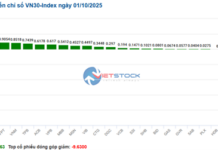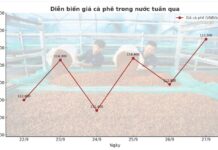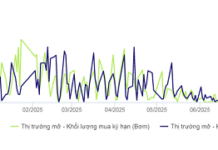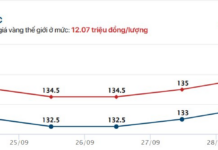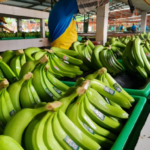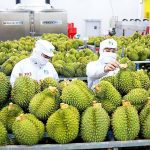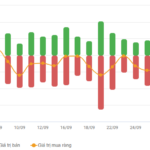In 2024, Vietnam’s banana production reached approximately 3 million tons, becoming one of the key export commodities with a turnover of nearly $380 million, ranking 9th globally. This remarkable achievement is most evident in major importing markets in Asia, such as China, Japan, and South Korea. Notably, Japan has long been considered the stronghold of Philippine bananas, but this dominance has been recently challenged by the increasing popularity of Vietnamese bananas.
Outperforming Many Rivals
According to Nikkei Asia, Vietnamese bananas are gradually capturing market share from competitors due to their freshness and competitive pricing. Japan’s trade statistics reveal that in 2024, the country imported 33,000 tons of bananas from Vietnam, nearly 14 times higher than in 2019. Specifically, in July 2025, the volume of Vietnamese bananas exported to the Tokyo area more than doubled compared to the same period last year. Although the market share in Japan is only at 3.25%, this growth rate is still impressive.
In the Chinese market, the world’s largest banana consumer, Vietnam has also made a historic step forward. In 2024, China’s total banana imports reached 1.69 million tons, valued at $908 million, a slight decrease from 2023. However, Vietnamese bananas continued to surge, reaching 625,000 tons, worth $261 million, an increase of 28% in volume and 7% in value. In contrast, bananas from the Philippines witnessed a significant drop of 32% in volume and 39% in value. This is the first time that Vietnamese bananas have officially surpassed those from the Philippines in this billion-people market.
South Korea is another important destination. According to the Vietnam Fruit and Vegetable Association, in June 2025, bananas brought the highest export value in this market, surpassing mangoes, dragon fruits, and watermelons, with a value of $25.4 million, despite a 19% decrease from the previous year. In the first six months of 2025, bananas ranked third in the group of exported fruits from Vietnam, only after durians and dragon fruits, with a turnover of $233 million, an increase of nearly 55% over the same period last year.
Mr. Dang Phuc Nguyen, Secretary-General of the Vietnam Fruit and Vegetable Association, attributed the success of Vietnamese bananas in the past years to several factors, including favorable output, good prices in the first months of the year, and significant improvements in quality and appearance. “Vietnamese bananas can be said to meet the criteria of ‘delicious, nutritious, and affordable,’ making them popular in the market,” Mr. Nguyen illustrated. In addition, the advantage of low transportation costs due to geographical proximity to import markets is also a significant plus point, especially compared to the Philippines or South American suppliers. Furthermore, the Panama disease, which affected banana production in the Philippines, created an opportunity for Vietnamese bananas to expand their market share.
However, Mr. Nguyen also acknowledged that in the past, Vietnamese bananas faced a situation where farmers had to seek rescue solutions due to their lack of cultivation experience and overlapping harvest times with China’s domestic banana season. Nowadays, thanks to lessons learned and adjustments in the harvest schedule, this situation has been largely mitigated, except for some years with unusual weather patterns. In addition to fresh exports, some localities have experimented with processing bananas into dried bananas, banana powder, or utilizing by-products for animal feed and handicraft production to increase their value.
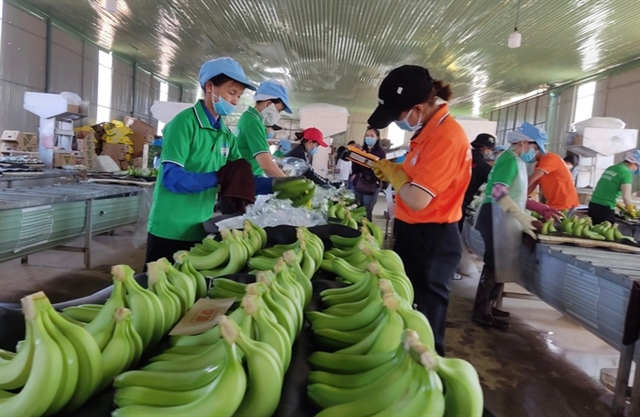
Fresh banana processing at Hoang Anh Gia Lai Joint Stock Company |
Need for a More Comprehensive Strategy
Mr. Pham Quoc Liem, Vice President of the Vietnam Fruit and Vegetable Association and Chairman of the Board of Directors and General Director of U&I Agriculture Joint Stock Company (Unifarm), expressed optimism that Vietnamese bananas could join the “billion-dollar export club.” According to Mr. Liem, the market share of Vietnamese bananas in Japan is just over 3%, while the global banana trade is valued at $15 billion per year, and the demand continues to grow, indicating significant potential. “There is a shortage of banana supply due to diseases in traditional growing regions such as Ecuador, the Philippines, Australia, and even China. This presents an opportunity for new growing regions in Vietnam, Cambodia, and Laos,” Mr. Liem analyzed.
Vietnam currently has approximately 160,000 hectares of banana plantations. Assuming only 30% of this area is dedicated to exports, and with an average revenue of $25,000 per hectare, as achieved by standard growing regions, the target of $1 billion per year is definitely within reach.
Nevertheless, the journey to reaching the $1 billion milestone for Vietnamese bananas is fraught with challenges. Unlike many other agricultural products, bananas do not have a “golden season” towards the end of the year. Instead, this period tends to see slower consumption, making it difficult for annual revenue to surge significantly. With a turnover of $233 million in the first six months of 2025, an increase of nearly 55% over the same period last year, it is projected that the total banana export turnover for the entire year will struggle to reach $500 million. This implies that the $1 billion target remains a long-term plan, necessitating a comprehensive strategy and coordinated efforts from production to consumption.
The leader of Unifarm emphasized that to foster sustainable development in the banana industry, it is crucial to diversify export markets. “Currently, China accounts for 70% of Vietnam’s total banana exports, so expanding to Japan, South Korea, the Middle East, Europe, and other regions is essential to mitigate the risk of dependence on a single market,” Mr. Liem stated.
|
Banana is one of the strategic crops of Hoang Anh Gia Lai Joint Stock Company, chaired by Mr. Doan Nguyen Duc (known as Chairman Duc). With a banana cultivation area of 7,000 hectares, bananas have become the main source of revenue for the company, helping it overcome challenging periods. According to Chairman Duc, the advantages of banana cultivation include the potential for industrial-scale production, limited competition from small-scale farmers, ease of preservation and transportation, and official exports to China by sea at low costs. |
Article and photos: Ngoc Anh
– 06:00, August 14, 2025
The Green Banana Boom: A Tasty Treat Worth its Weight in Gold
The peaceful province of Hoa Binh has witnessed an intriguing phenomenon, with traders snapping up banana gardens at an astonishing rate of 500,000 VND per bunch. This unusual scenario has caught the attention of many, leaving people curious about the reasons behind these generous offers. The province’s banana gardens have become a hot commodity, and the question on everyone’s mind is: What makes these bananas so special?
China, US Boost Imports of Vietnamese Fruits and Vegetables
The global demand for Vietnamese fruits and vegetables is surging, with major markets such as China, the US, and South Korea leading the way. In the first half of the year, these countries have significantly ramped up their imports from Vietnam, resulting in impressive double-digit growth rates. With this strong momentum, the industry is on track to shatter records, aiming for a remarkable $7 billion milestone by the end of the year.


